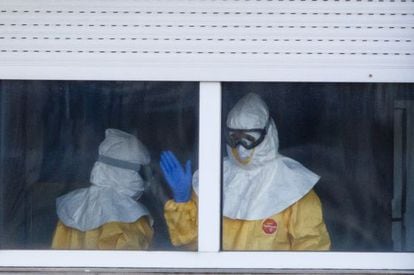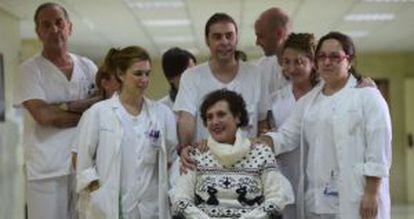Multiple deficiencies uncovered at hospital that treated Ebola victims
Madrid’s Carlos III had confusing protocols and inadequate personnel training, report finds

The Madrid hospital where nursing assistant Teresa Romero contracted Ebola while treating an infected patient suffered from multiple deficiencies, a new report finds.
Insufficient personnel training, changing protocols, inadequate facilities for putting on and taking off protective suits, and other shortcomings were all listed in the study of La Paz-Carlos III hospital carried out by work inspectors.
The center has treated all of Spain’s Ebola cases, which include two patients repatriated from Africa as well as Romero, who was an employee there. Several dozen people who came into contact with the nursing aide while she was contagious were also kept under observation at Carlos III.
The report will go a long way towards determining who is responsible for the nursing aide’s ordeal
The report, to which EL PAÍS has had access, concludes that the capital’s Gómez Ulla military hospital would have been a better choice for dealing with Ebola cases.
The two inspectors in charge of the case noted that several security measures and protocols now in place at Carlos III were only adopted after Romero’s accidental infection, not before.
The report will go a long way towards determining who is responsible for the nursing aide’s ordeal. Romero was discharged on November 5 after battling the disease for a month. During this time, the Madrid regional health chief publicly suggested that the nursing aide was solely to blame for her predicament because she made a mistake removing the protective suit when she went in to clean an Ebola patient’s room.
The wrong hospital for Ebola
The inspectors' report states that Madrid's Gómez Ulla military hospital, not Carlos III, should have taken charge of the Ebola cases in Spain. But Gómez Ulla was not ready by July 2014, as it should have been, so instead it was hurriedly decided to prepare the sixth floor of Carlos III to receive Ebola patients instead. The first, a missionary, arrived in August. "The repatriation of the first patient caught us a bit by surprise," admits the hospital's deputy general manager, Mercedes Fernández.
It was in this context that the decision was made to admit Ebola-infected missionary Miguel Pajares in August. The Gómez Ulla was not ready, the regional government said.
On November 7, the Cabinet approved a decision to invest €2.5 million in remodeling the Gómez Ulla to turn one of its floors into "a high-level hospital isolation unit." A further €4 million was recently announced for 2015.
The official, who has since been removed from his post, based his accusation on Romero’s own statements made soon after her hospital admission, in which she said she had touched her face with a glove. Following her discharge, however, Romero denied any recollection of the incident, and is now suing regional authorities for damages.
Several doctors and a medical union also filed official complaints about the situation at Carlos III. “Work Inspection’s findings are proving us right,” said a spokesman for the union CSI-F. “They prove the facts we denounced before the Attorney, irregularities that have put workers’ health at risk.”
The report finds that the hospital purchased the kind of self-ventilating hazmat suits recommended by doctors, but that these were never used because of “difficulties maneuvering inside the air lock and the need for training.” The hospital’s deputy general manager, Mercedes Fernández, said the suits were never employed because intensive care maneuvers were never necessary.
The correct way to put on and remove the suit was “succinctly” explained and did not take the size of the room into account, the report also finds.
Another key element is whether there were trained supervisors to ensure that workers were removing protective overalls correctly. Supervisors existed prior to the Romero incident, but they lacked specific training in occupational hazards. The inspectors note that walking in and out of an Ebola patient’s room is “a very dangerous activity” and should have been properly supervised.

Suit training consisted of a 15 to 20 minute lecture and a 25-minute practical demonstration on how to put on and remove the gear. Inspectors also say that there were no drills to train workers inside the Ebola isolation area, or to show them special post-mortem procedures.
Inspectors counted up to six different protocols issued by the Health Ministry and the hospital itself, before and after Romero contracted the disease. “There was a dispersal in terms of definition, guidelines and measures adopted in the global context of the hospital complex regarding the risk [of Ebola],” they found.










































